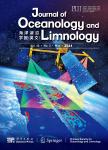Diagenetic control of magnetic susceptibility variation in Core MD98-2172 from the Eastern Timor Sea
Diagenetic control of magnetic susceptibility variation in Core MD98-2172 from the Eastern Timor Sea作者机构:State Key Laboratory of Geological Processes and Mineral ResourcesChina University of Geosciences School of Marine ScienceChina University of Geosciences
出 版 物:《Chinese Journal of Oceanology and Limnology》 (中国海洋湖沼学报(英文版))
年 卷 期:2010年第28卷第6期
页 面:1350-1361页
核心收录:
学科分类:070801[理学-固体地球物理学] 07[理学] 0708[理学-地球物理学]
基 金:Supported by the National Basic Research Program of China (No. 2006CB701400) the National Natural Science Foundation of China (Nos. 40621002,40974035,40272074) Projects of Ministry of Education of China ("111" Project B07011,IRT0546)
主 题:Eastern Timor Sea susceptibility reductive diagenesis fine detrital particles
摘 要:Detailed mineral magnetic measurements, integrated with grain-size distribution and X-ray diffraction (XRD) analyses, were made on the marine sediments of Core MD98-2172, retrieved from the Eastern Timor Sea. Values of magnetic susceptibility in this core drop sharply down-core from -3.85 m deep below sediment/water interface and are very low at -5.35 m. However, both XRD and grain-size distribution results show no sudden change in terrigenous input during sedimentation. Mineral magnetic results indicate that the depth of -3.85 m may be an oxic/anoxic boundary. Therefore, the sediments below -3.85 m have been subjected to intense reductive diagenesis, whereas the sediments above -3.85 m are seldom affected. The magnetic properties of the sediments shallower than 3.85 m are dominated by pseudo-single domain (PSD) magnetite, with little down-core variation in its content and grain size. Below -3.85 m, the magnetic mineral assemblages that have survived in the sediments may record different stages of the reductive diagenesis: (1) the sediments from the 3.85-5.35 m interval are at the stage of iron oxide reduction; t'SD magnetite is the major magnetic contributor, but it becomes less abundant and coarser down-core; (2) the sediments below -5.35 m are at the stage of sulphate reduction; ferrimagnetie minerals almost vanish and paramagnetic minerals contribute to down-core susceptibility variations, including pyrite as evidenced by high-temperature magnetic susceptibility measurements. However, the susceptibility variations below -5.35 m of Core MD98-2172 show obvious periodicity, despite the intense effect of reduetive diagenesis. Furthermore, the down-core susceptibility variations are coincident with fluctuations in the quantity of fine detrital particles (〈8 μm), which may come mainly from the advection of the Indonesia Throughflow (ITF) and/or river input from Timor. Therefore, for Core MD98-2172, susceptibility variation below -5.35 m, which potentially correspond t



